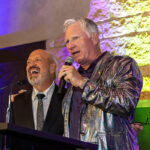Lessons on Teaching From UT’s 35th New Faculty Orientation
Professor Bob Duke began his lecture, titled “If We Learn Like That, Why Do We Teach Like This?” with a 90-second viral video of a Japanese boy playing a Jason Mraz song on a ukelele. The group attending the afternoon session of UT’s 35th New Faculty Orientation ooh’d and aww’d as the adorable cherub clunkily plucked away at his instrument—nearly as large as his body—and sang gibberish along with the song’s melody.
In what could have been simply a mixer for new faculty, Duke used his hour to share lessons about teaching at the college level using unconventional methods like YouTube videos and word problems. Duke’s lecture was part of a series of panel discussions and sessions from seasoned UT faculty—plus a Friday morning welcome from new UT president Greg Fenves—over the course of two days during the orientation. The purpose, beyond helping new faculty members break the ice and acclimate to a new, large campus, was to integrate them into UT’s culture of research, teaching, and service.
Duke, a professor in the Butler School of Music and director of the Center for Music Learning, used the cute video to remind nervous new professors not to sweat the details. The little boy can’t keep time, and he doesn’t know enough English to sing any of the words, but, Duke said, he understands what music is for, and his sheer joy shines through. His performance is full of technical errors, but it clearly makes him happy—and so it makes viewers (65 million and counting) happy, too. Duke stressed that errors are an important—and obligatory—aspect of the learning process.
Duke also argued that these errors can cause confusion, which, as long as it is strategically calculated, is a good thing in a learning environment.
In another lesson, he relayed a balance puzzle involving a scale and nine boxes, one containing a single $100 bill, and thus, marginally heavier. Using the scale only twice, which box has the cash inside? He gave the room a minute to try to solve the puzzle, and afterward, instead of giving the answer, told a story about withholding the answer from one of his classes years earlier. Students followed him after class, begging for the solution, but he wouldn’t budge. As he was asking strategic questions about the puzzle to get them thinking about possible solutions, and the students were working together to reach the correct conclusion, one woman blurted out, “I know it!”
His plan had worked. The strategic confusion Duke created forced a student to think critically and find the solution.
“No explanation I could have given her would have matched how she felt,” Duke said. Those moments, when the lesson transcends the classroom and students are having auxiliary discussions, signal effective learning, he said. Of course, he didn’t disclose the answer to this audience, either.
Additionally, Duke acknowledged that even experts in their discipline have to navigate variables in types of students, learning environments, and even day-to-day moods. There’s no trick or shortcut to becoming an effective teacher, even if you have a PhD, which is why a series on teaching for new faculty may be particularly effective at getting teachers to self-evaluate and collaborate with their peers before classes begin.
“There’s an acceptance that this requires practice,” Duke said after the symposium. “It’s an unfortunate truth that all teachers learn to teach on students.”


















No comments
Be the first one to leave a comment.